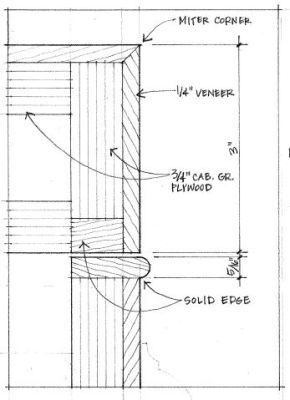1/4" Solid Wood on 3/4" Plywood
Thinner veneers in a balanced layup are the way to prevent trouble down the road. March 22, 2013
Question
I have a job calling for 1/4" solid wood veneer on 3/4" plywood substrate. The 1/4" cypress will be a random width pattern that will flow across doors, drawer fronts, and side panels. Any advice on the best method to apply the 1/4" boards? I'm hoping for a more sophisticated method than glue and nails. I do have a veneer vacuum bag but don't see it being used in this case.

Forum Responses
(Cabinetmaking Forum)
From contributor D:
To start, you need to balance the panels with the same wood/thickness on both sides, just like veneer. I think you also want to get down to 1/8" thick cypress in lieu of the 1/4". More like veneer and less like solid wood, movement-wise. There is no reason that it all shouldn't be done in a vacuum press with proper glues. Panels can be made slightly oversize. This is no place for nails.
From contributor D:
Maybe you could get some cypress laid up in sheet goods?
From contributor I:
1/4" is too thick. You are dealing with solid wood at this point, not veneer. People claim that they get away with this, and they will tell you they do it all the time. Either the finished work is in a really stable climate, or there are in fact problems. I made this mistake with an early piece, and it took 5 years for a failure to occur. This was in a climate controlled home, in a moderate climate. 1/8 is about as thick as you want to go. I would start out at 1/8" before sanding, so that the final thickness is no more than 3/32".
From contributor C:
You've gotten some pretty good advice so far and I can only ad that I have been working with veneer for nearly 35 years and 1/16th to 1/8th is the limit to thickness based on my experience. Anything thicker will eventually fail in some way as there is nowhere for the wood to move. Splitting and delaminating will be the result!
When veneering plywood or solid wood, balancing what you do on one side with the same treatment on the other is the safest approach. However, and I'm sure I will be peppered with comments from those who adhere to this particular wisdom, I have seen many museum pieces that are veneered only on the show side and have survived several hundred years. So one could argue that you only really need to veneer one side. However, if you are doing this work for a client or customer, don't take the chance - veneer the backside too!
From contributor L:
I totally agree about not using 1/4" solids. That's not veneer and will fail. I also think balancing the panel is a very good idea. I wouldn't do otherwise. I've got a band resaw and make veneers for special uses. Works great but the final veneer thickness is held to 3/32" max. For your project just tape up the parts like for any veneer project, use one of the veneer glues and a vacuum bag. Trim to size after veneering. I prefer MDF or PBD for a substrate.
From contributor S:
If I resaw thin planks for gluing onto substrate, do I tape planks together, then glue? Do the thin planks (veneers) need edge glue where they meet? Thanks for all the experienced answers.
From contributor L:
In doing veneer work we don't glue edge to edge, just use veneer tape. It has holes punched in it so you can see the fit. As it dries, it shrinks a little to draw the parts together tightly. (Assumes you have cut the parts to a good fit.)
If this is your first veneer work, do a test panel. The places that sell veneers and vacuum systems have good online information and videos. They also have some good DVDs you can buy. One of the most impressive tricks is veneering a round table top with a radius edge. Veneering is fun. There are some great examples on WOODWEB.
From contributor I:
Veneer tape works well, and this is very much the standard method that most people use. Out of stubbornness I like to edge glue thicker veneers, but there is a whole trick for doing that using only masking tape to clamp the two veneers together. The only people I have met who do it this way are Krenov students.
If you have never done any major veneer work before, start by practicing with some small panels. Get creative and have some fun. There is a slight learning curve, especially when it comes time to spread glue, and lay up the veneer onto the substrate while getting everything in the press before it is too late without making a mess, or letting the veneer slip.
Finally, use your vacuum bag. Unless you want to get into old school techniques such as veneer hammering, or you have a gigantic screw press with a mountain of cauls, this is really the only way to go.
From contributor V:
I'd suggest regular veneer combined with solids. Cross-band 2 or 3 plies if you want it thicker. Even then it's likely cheaper than making your own and you'll get a lot better grain match. As has been suggested, use standard (not PSA) paper veneer tape. I prefer no holes so I can wet it and peel it off (without wetting the veneer).
